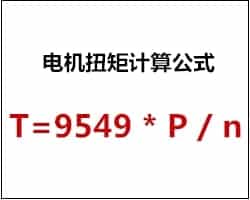The concept of power is the work done per unit time.
Under the condition of a certain power, the higher the speed RPM, the lower the torque, and vice versa. For example, the same 1.5kw motor, the 6-stage output torque is higher than the 4-stage.
The formula M=9550P/n can also be used for rough calculation.
For AC motors: rated torque = 9550 * rated power / rated speed;
for DC motors is more difficult because there are too many types.
Roughly, the speed is proportional to the armature voltage and inversely proportional to the excitation voltage.
Torque is proportional to excitation flux and armature current.
In DC speed control, adjusting the armature voltage belongs to constant torque speed control (motor output torque is basically constant)
In adjusting the excitation voltage is a constant power regulation (motor output power is basically constant)
T = 9.55*P/N, T output torque, P power, N speed, the motor load has a constant power and cross-torque, constant torque, T constant, then P and N is proportional relationship.
The load is constant power, then T and N is basically the inverse relationship.
Torque = 9550*output power/output speed
Power (W) = RPM (rad/s) x Torque (N. m)

In fact, there is nothing to discuss, there is already the formula P = Tn/9.75 .
T unit is kg-cm, torque = 9550 * output power / output speed.
Power is certain, the speed is fast, the torque is small, generally need a larger torque, in addition to the need for a high power motor, but also add another reducer.
It can be understood that the higher the rotational speed, the smaller the output torque when the power P is constant.
We can calculate like this:
If you know the torque of the equipment T2 and the rated speed of the motor n1 and the output shaft speed n2 and drive the equipment system f1 (this f1 can be defined according to the actual operation of the site, most of the domestic 1.5 above) and the motor power factor m (that is, the ratio of work to total work, in the motor winding can be understood as the slot full rate, generally in 0.85)
we calculate the motor power P1N. Power P1N. P1N>=(T2n1)f1/(9550(n1/n2)m) can be derived from the power of the motor you want to select at this time.
For example: the torque required by the driven equipment: 500N.M, work 6 hours / day, uniform load can be selected driven equipment factor f1 = 1,
the reducer requires flange mounting, the output speed n2 = 1.9r / min then the ratio of.
n1/n2 = 1450/1.9 = 763 (here is the choice of four-stage motor)
Therefore: P1N> = P1 * f1 = (500 * 1450) * 1 / (9550 * 763 * 0.85) = 0.117 (KW) so we generally choose 0.15KW speed ratio is about 763 enough to cope with
T = 9.55 * P / N, T output torque, P power, N speed, the motor load has a constant power and cross-torque points, constant torque, T constant, then P and N is proportional relationship.
The load is constant power, then T and N is basically the inverse relationship.
Пожалуйста, свяжитесь с производителем электродвигателя, как показано ниже, чтобы получить дополнительную информацию об электродвигателе;

Получите бесплатное предложение от Dongchun Motor
Если есть какие-либо комментарии, добро пожаловать, чтобы оставить мне сообщение.









2 Ответы
I bⅼog often and I seriouѕly appreciate your information. Thе article has really peaked
my interest. I will book mark your site and keep checking for new details about
once a week. I opted іn for youг Feed as well.
WELCOME!